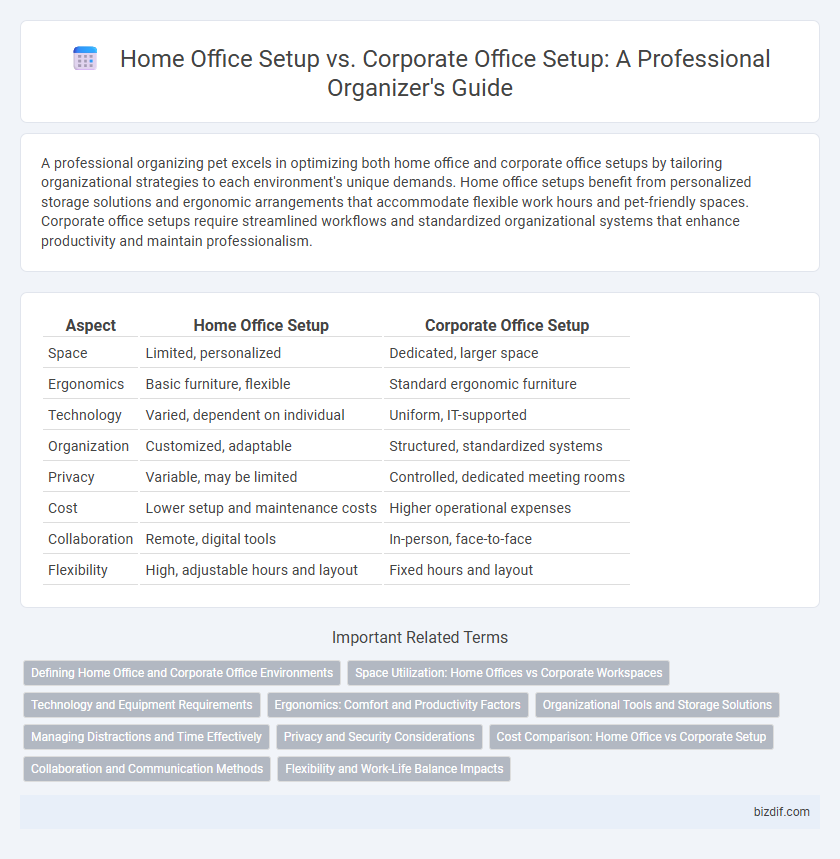A professional organizing pet excels in optimizing both home office and corporate office setups by tailoring organizational strategies to each environment's unique demands. Home office setups benefit from personalized storage solutions and ergonomic arrangements that accommodate flexible work hours and pet-friendly spaces. Corporate office setups require streamlined workflows and standardized organizational systems that enhance productivity and maintain professionalism.
Table of Comparison
| Aspect | Home Office Setup | Corporate Office Setup |
|---|---|---|
| Space | Limited, personalized | Dedicated, larger space |
| Ergonomics | Basic furniture, flexible | Standard ergonomic furniture |
| Technology | Varied, dependent on individual | Uniform, IT-supported |
| Organization | Customized, adaptable | Structured, standardized systems |
| Privacy | Variable, may be limited | Controlled, dedicated meeting rooms |
| Cost | Lower setup and maintenance costs | Higher operational expenses |
| Collaboration | Remote, digital tools | In-person, face-to-face |
| Flexibility | High, adjustable hours and layout | Fixed hours and layout |
Defining Home Office and Corporate Office Environments
Home office setups prioritize personalization, flexibility, and compact space optimization, designed to accommodate individual workflows and reduce distractions. Corporate office environments emphasize standardized layouts, ergonomic furniture, and collaboration zones to foster teamwork and maintain consistent productivity across employees. Understanding these distinctions aids in tailoring organizational strategies that enhance efficiency and comfort in both settings.
Space Utilization: Home Offices vs Corporate Workspaces
Home office setups prioritize efficient space utilization by maximizing multifunctional furniture and vertical storage to adapt to limited square footage. Corporate workspaces typically allocate dedicated zones for collaboration, private work, and storage, optimizing large-scale layouts and ergonomic design. Both environments leverage strategic organization techniques to enhance productivity while catering to different spatial constraints and employee needs.
Technology and Equipment Requirements
Home office setups demand versatile technology that enhances remote communication, such as high-quality webcams, noise-canceling headsets, and reliable Wi-Fi routers, to maintain productivity outside traditional corporate environments. Corporate office setups typically require integrated systems including multi-user printers, dedicated servers, and advanced teleconferencing equipment to support collaborative workflows and IT infrastructure. Both settings benefit from ergonomic accessories like adjustable monitors and keyboard trays, but the scale and network complexity differ significantly based on organizational needs.
Ergonomics: Comfort and Productivity Factors
Home office setups prioritize personalized ergonomic solutions such as adjustable chairs, sit-stand desks, and individualized lighting to enhance comfort and reduce strain during extended work hours. In contrast, corporate office setups often standardize ergonomic furniture and layouts to accommodate diverse employee needs while maximizing space efficiency and compliance with occupational health regulations. Both environments emphasize ergonomic factors to boost productivity, minimize musculoskeletal issues, and promote long-term wellness.
Organizational Tools and Storage Solutions
Home office setups require versatile organizational tools like adjustable desktops, modular shelving, and compact filing systems designed for limited space, enhancing productivity and accessibility. Corporate office setups prioritize scalability with standardized storage solutions, such as large filing cabinets, built-in cabinetry, and centralized supply stations, ensuring uniformity across multiple workstations. Efficient storage solutions tailored to each environment optimize workflow and reduce clutter, benefiting both individual and team-based tasks.
Managing Distractions and Time Effectively
Home office setups demand personalized strategies to minimize distractions, such as designated work zones and scheduled breaks, which enhance focus and productivity. Corporate office environments often rely on structured routines, collaborative workspaces, and clear boundary-setting policies to manage interruptions and maintain efficient time use. Both settings benefit from using digital tools like task management apps and noise-canceling devices to optimize concentration and time management.
Privacy and Security Considerations
Home office setups demand rigorous privacy measures, including secure Wi-Fi networks and encrypted data storage, to protect sensitive information from cyber threats. Corporate office environments typically employ advanced security infrastructures such as VPNs, biometric access controls, and dedicated IT support to ensure comprehensive data protection and physical security. Maintaining confidentiality in both settings requires tailored strategies addressing the unique risks posed by their respective operational contexts.
Cost Comparison: Home Office vs Corporate Setup
Home office setups typically incur lower initial costs, averaging $500 to $1,500 for essential furniture and technology, compared to corporate office setups which can exceed $10,000 per employee due to higher-grade office furniture, IT infrastructure, and shared amenities. Ongoing expenses for home offices include utilities and office supplies, but corporate offices involve additional operational costs like facility maintenance, security, and administrative support. Businesses save significantly on overhead by encouraging remote work, while employees investing in their home offices benefit from personalized ergonomics and reduced commuting expenses.
Collaboration and Communication Methods
Home office setups typically rely on digital collaboration tools such as video conferencing, instant messaging, and cloud-based project management platforms to maintain effective communication and teamwork. Corporate office setups benefit from face-to-face interactions, structured meeting spaces, and dedicated conference rooms that facilitate spontaneous discussions and direct collaboration. Balancing synchronous and asynchronous communication methods enhances productivity and ensures seamless coordination across both home and corporate office environments.
Flexibility and Work-Life Balance Impacts
Home office setups offer unmatched flexibility, supporting personalized scheduling and immediate access to personal amenities, which enhances work-life balance by reducing commute time and allowing for tailored break periods. Corporate office environments, while structured, provide clear boundaries between professional and personal life, often promoting social interaction and formal collaboration but can limit flexibility due to fixed hours and commute requirements. Optimizing home office organization with ergonomic furniture and designated work zones can further improve productivity and balance, directly impacting mental well-being and job satisfaction.
home office setup vs corporate office setup Infographic

 bizdif.com
bizdif.com